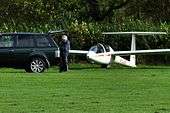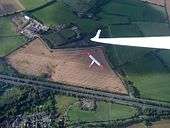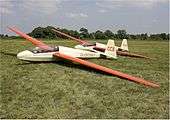Oxford Gliding Club
Native name | Oxford Gliding Club |
|---|---|
| Founded | Cumnor Meadow (See Farmoor Reservoir (December 3, 1937) |
| Founder | Robert Sutherland H H Price Gilbert Ryle and Frederick Lindemann |
| Headquarters | Weston-on-the-green, United Kingdom |
Number of locations | (Past) Cumnor Meadow, Aston Rowant London Oxford Airport Current: RAF Weston-on-the-Green |
Area served | Oxfordshire |
| Services | Aviation,Gliding |
Number of employees | 80+ Members |
| Website |
www |
Oxford Gliding Club [1] operates at RAF Weston-on-the-Green, north of Oxford. The club celebrated its 75th anniversary in 2012.
Club history
The pre-war ancestor to the Club was the "Oxford University and City Gliding Club" which had its inaugural meeting at Christchurch College on Thursday 2 December 1937. The founders were predominantly Oxford academics, including author and anthropologist Robert Sutherland Rattray, Professor H H Price, philosopher Professor Gilbert Ryle and physicist Professor Frederick Lindemann, 1st Viscount Cherwell (later Lord Cherwell). They were helped in their search for a suitable site by aviator Amy Johnson. Frederick Lindemann went on to become scientific advisor to Winston Churchill and was paymaster general during World War II.
Historical operations
Flying began on Saturday, 7 May 1938, at a site known as Cumnor meadow, which is now on the bed of Farmoor Reservoir. The Club fleet consisted of two open primary gliders, one of which had a streamlined nacelle. Club members had to build an access road to the site, including a bridge over a ditch, and a basic hangar. The famous Austrian gliding pioneer, Robert Kronfeld became manager and CFI (Chief Flying Instructor) of the Club in June 1938. Club pilots and gliders took part in a public Air Show at RAF Upper Heyford in the summer of 1938. The Club moved from Cumnor to the Chiltern ridge at Aston Rowant, close to the Lambert Arms pub, for the 1939 season. The formation of the Oxford Gliding Co. Ltd. dates from 1939, including the original £4,000 share capital which is still on the books to this day. On the outbreak of war in 1939, all recreational aviation ceased, and the club was eventually reformed at Kidlington (London Oxford Airport)in 1951. An increase in powered aircraft activity at Kidlington resulted in the club relocating to RAF Weston-on-the-Green in 1956.
Club operations
Glider fleet
The highest performance club glider is the Glaser-Dirks DG-505, a two-seater which is used for cross-country training. Interchangeable wingtips allow this glider to be operated in three different modes. The club also has two Grob Astirs, which are of GRP construction. The club has two Schleicher ASK 13 two seat gliders, which are used for training pilots to solo standard. These are of a tubular steel frame and wood construction. Once competent to fly solo, pilots can convert to the Schleicher K 8, which has similar handling to the K13, and are of a similar construction. Finally, the Slingsby T.21 is a vintage open cockpit side-by-side two seat glider.[2]
Launches
The club uses a self-manufactured winch, which can give launches of 1200 feet or higher. It uses two steel drums which weigh approximately 100 kg with 1750 metres of steel cable in a seven-strand setup.

The cables are distributed by Skylaunch.[3] The winch is operated by all solo pilots of the club who fulfill the conditions of being;
- Solo pilots
- Over 16 with a winch instructor (Over 18 without)
- Cleared by a suitably qualified winch instructor.
The club is unable to use the aerotow method of launching gliders, primarily due to the lack of a suitable "tug" aircraft.
Club fleet
Two-seater aircraft
| Aircraft | Call Sign | Notes |
|---|---|---|
| Glaser-Dirks DG-505 | G-CJSX | A high-performance aircraft that can be used for trial flights, but primarily used by the club for conversions to the club's two Astir types, introduction and tests of soaring capabilities of pilots and tasks which the K13 or T21 would not be able to perform. |
| Slingsby T.21 | WJ306 | Originally a RAF Cadet glider. Built in Shropshire by Slingsby Aviation. It still bares the original RAF livery and roundels, with special permission of the Air Training Corps. Used as an aerial platform suitable for trial flights, pleasure flights and has been a feature at the Royal International Air Tattoo |
| Schleicher ASK 13 | G-DCGO, G-DCCE | The Club uses its K13s as its main gliders. They are used for training, and as such carry a suitable array of dual instruments, dual controls and dual radio inputs. The K13s are used for training, trial flights and other club uses, such as the British Gliding Association Bronze Badge check flights.[4] |
 The Glaser-Dirks DG-505 being prepared for a flight at Talgarth |
 The clubs Slingsby Aviation T21 in a thermal. |
 The clubs Schleicher ASK 13s at the launch point. |
Single-seater aircraft
| Aircraft | Call Sign | Notes |
|---|---|---|
| Schleicher K 8 | G-CHFW G-DCYZ | A solo version of the K13, it is what solo pilots convert to once they have trained in the K13s, and had a minimum of 6 solo flights in the K13. Known for its docile handling characteristics, it has been known to frequently outclimb modern gliders with its ability to fly at very slow speeds, and centre thermals easily. It is very popular with vintage pilots.[5] |
| Grob Astir | G-DDMH G-DDKR | Higher-performance single-seater than the K8, often transitioned to after successful flights in the clubs DG505, and with BGA Bronze flying ability. |
| One of the clubs Schleicher K 8 preparing for a flight. |
One of the clubs Grob Astirs landing. |
References
British Gliding Association
External links
- Official Oxford Gliding Club Website
- Images of the club fleet on ABPIC
- Gliding in the snow - UK Airshow Review